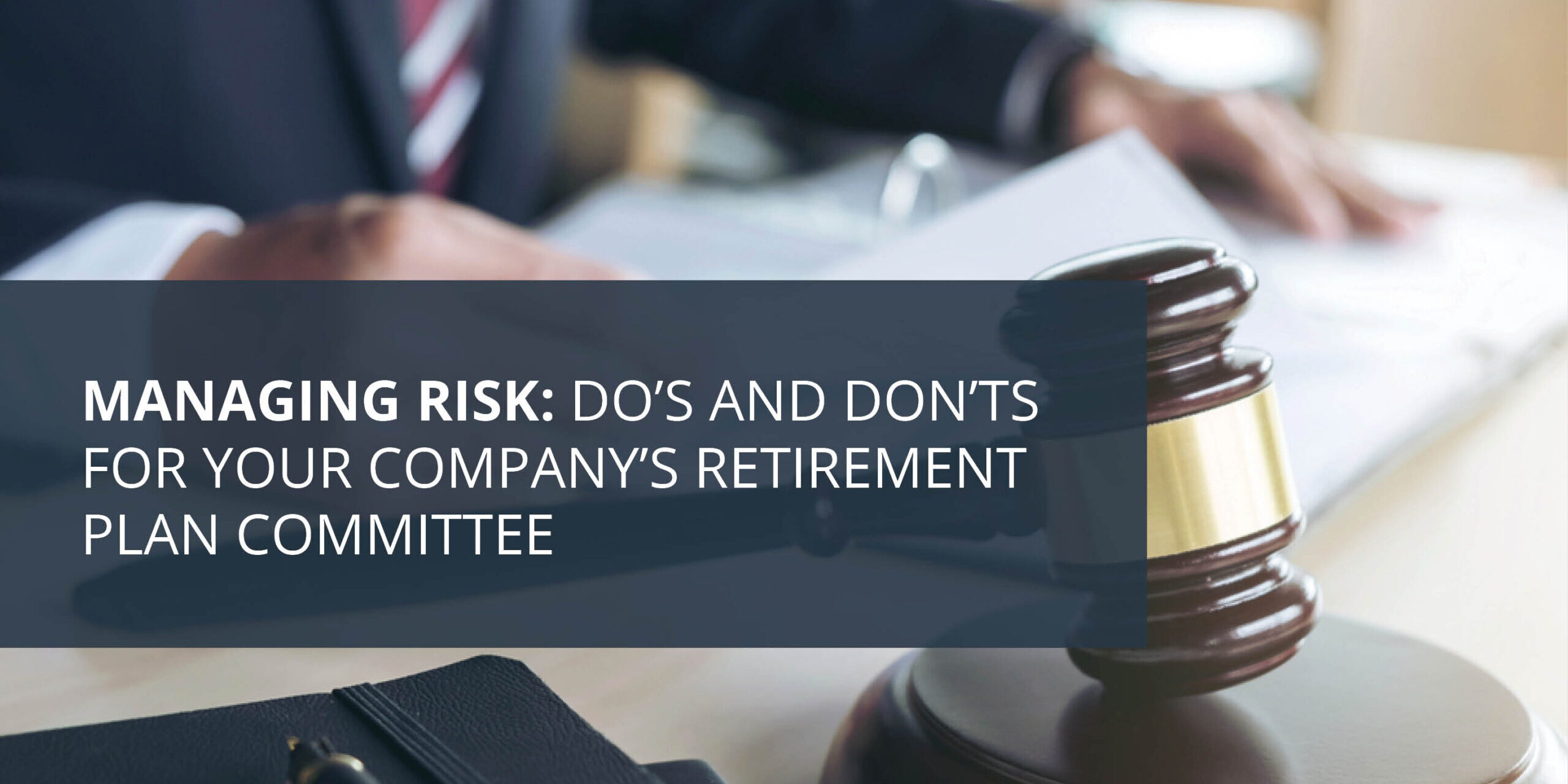Search Posts
Recent Posts
- Video 2021-Q3: 20 Questions To Benchmark Your 401(k) September 14, 2021
- Cycle 3 401(k) Deadline quickly approaching August 31, 2021
- Do You Want to Be Taxed Now or Later? August 17, 2021
- What’s the buzz about PEP, MEPs and SEPs? August 3, 2021
- Plan Sponsor Guide 2021 Q3: Different Types Of Workplace Plans July 20, 2021
Categories
Subscribe!
Thanks for subscribing! Please check your email for further instructions.

Managing Risk: Do’s and Don’ts for Your Company’s Retirement Plan Committee
Scan the business news and you will likely find an article detailing the latest 401(k) litigation against a company accused of a fiduciary breach. The litigious trend started with corporate behemoths but has been trickling down to small and mid-size plans.
Adding to this, a survey found that 43% of company fiduciaries don’t actually think they are fiduciaries.[1]
“We see this regularly and stress that plan sponsors need to understand their fiduciary responsibility and all that it entails,” said Roger Levy, AIFA, an Analyst for the Centre for Fiduciary Excellence (CEFEX). CEFEX is an independent certification organization that works closely with industry experts to provide comprehensive assessment programs to improve the fiduciary practices of investment stewards, advisors, recordkeepers, administrators and support services firms.
“Even if a company outsources their fiduciary oversight for some aspects of their retirement plan, they still have certain obligations under the law,” says Levy. As a plan sponsor, you are still responsible for adhering to the Department of Labor’s Employee Retirement Income Security Act of 1974 (ERISA) guidelines, which govern and enforce the administration of 401(k) plans and their assets.
Here are five ways that plan sponsors can aim to lower fiduciary risk and stay in accordance with ERISA. If you have questions about the complexities of plan management, contact us for support.
- Plan Committee, IPS and Governing Documents
Establishing a plan committee is the first step in guiding the fiduciary oversight process. The committee should be a reasonable size and include experienced members of finance, HR and operations. In turn, members will be responsible for numerous aspects of plan management, often in conjunction with your retirement plan advisor.
Next, the investment policy statement (IPS) is a roadmap for investment oversight because it determines the prudent processes and criteria for selecting and monitoring plan investments. When the plan committee meets, it uses the IPS to benchmark and review funds, fees and whether the investment strategy is meeting its stated goals and objectives, among other things.
Additional governing documents include the plan document, trust statement and charter statements that should be read, reviewed, understood and followed by all committee members.
- Document the Investment Process
Documentation of process is critical in establishing fiduciary compliance. This includes recording minutes every time plan fiduciaries or investment committees meet to discuss investment changes or decisions. The documentation must show that due diligence has been taken in advance of a decision. “One of the biggest mistakes plan sponsors make is failing to properly document their investment decisions,” says Levy.
- Conduct oversight meetings
Investment committees should have regularly scheduled meetings (either annually, biannually or quarterly, depending on the size of the plan) to monitor the performance, evaluate service provider agreements and ensure that costs and fees remain reasonable.
Be careful of the tempting “set it and forget it” mindset that leads to infrequent monitoring and lack of process, which can result in a failure of fiduciary duties.
- Fund Choices
Offering numerous funds (i.e., “a fund for everyone”) does not reduce fiduciary risk. Rather, plan sponsors should conduct prudent due diligence to ensure that fund selection aligns with the IPS and corresponding investment strategies are appropriate.
The investment choices should not favor a particular asset class over another nor be overtly correlated to each other; however, the fund menu should provide a spectrum of risk and reward.
Underperforming funds should be monitored closely and replaced if necessary. Simply adding funds to counteract low performers increases fiduciary risk and can be interpreted as not fulfilling ERISA responsibilities.
- Fee transparency and reasonableness
Since the 2012 Department of Labor rule, the transparency of retirement plan fees has significantly improved. Each year, plan sponsors are provided with a disclosure and information detailing their retirement plan’s fees.
As a plan sponsor, it is your responsibility to verify the accuracy and reasonableness of all plan fees and document the benchmarking process.
The result?
A
win-win-win for the plan sponsor, advisor and participants!
[1] “Let’s be clear about fiduciary status.” J.P. Morgan. 10 Oct 2017. https://am.jpmorgan.com/us/institutional/library/lets-be-clear-about-fiduciary-status
